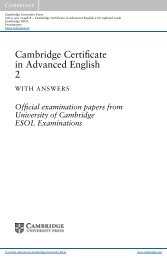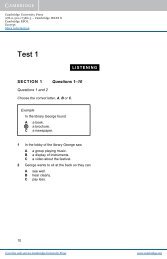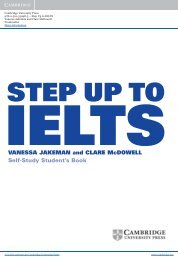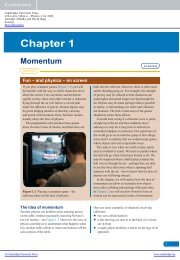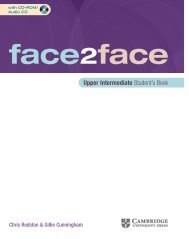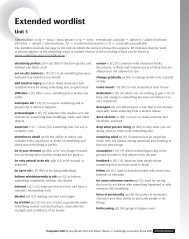4.23aSuggested answers1 The survey is an in<strong>for</strong>mal, small-scale one. There is no in<strong>for</strong>mation aboutthe criteria that were used to select the models used. It might suggest a linkbetween the attractiveness of the models and the customers’ responses, butit cannot be said to prove anything conclusively.2 Not really academically suitable, as they are based on an in<strong>for</strong>mal experimentconducted by an unnamed newspaper.3 The speaker concludes a strong link between the beauty of the modelsused and consumers’ preferences, though the evidence does not supportsuch a strong link. The speaker also concludes that standards of beautyare cross-cultural because the customers included people from a range ofethnic groups; again, this study does not show very strong evidence <strong>for</strong> thatconclusion.4 People may have gone to one booth rather than the other <strong>for</strong> a number ofreasons not connected to the attractiveness of the models. For example,people may have been attracted to the drink; one of the booths may havebeen set up in a more or less popular area of the shopping centre than theother; the staff in the booth may have been more proactive about trying toentice customers into the booth.4.33bAnswersTheme of talk: How advertisers use beauty to appeal to consumersClaims:1 Notions of what a ‘beautiful’ personis clearly vary between differentcultures.2 Criteria <strong>for</strong> judging beauty vary fromplace to place.3 Advertising within a culture issimpler than advertising betweencultures.Supporting points:Claims a preference amongmany white Europeans andNorth Americans <strong>for</strong> tanned skin,compared to a preference <strong>for</strong> palerskin among East Asians. However,no evidence <strong>for</strong> this is offered.USA: more focused on the shape ofthe body and even some notion of‘sex-appeal’Taiwan and Singapore: focuses moreon facial characteristicsCites a 2005 study by Frith et al.which found that US women’smagazine advertising tendedto focus more on clothing andthe body, while in Taiwan andSingapore, women’s magazineadvertising tended to focus onfacial products and cosmetics.Gives an example of a companyneeding to adapt its brand to localconditions, but offers no otherevidence except that already given.3c Students compare their ideas with a partner.Unit 4 Part A ∙ Understanding spoken in<strong>for</strong>mation 108
4.33dSuggested answersClaim 1 is rather weak, as it’s based only on anecdotal evidence. However, thespeaker is certain about it, as they say there is ‘clearly’ a difference in notionsof beauty between cultures.Claim 2 is slightly stronger, as it gives evidence from a study in support.However, the speaker says that it would be dangerous to conclude just fromthis one study that definitions of beauty did vary in this way, so they seemslightly less certain about this.3e Students decide their own response to the claims.3f Student discussionUnit Task: Designing buildings <strong>for</strong> human needsa & b Group discussioncAnswers4.4Main idea of the talk: That the physical features of a building (whetherarchitecture or indoor design elements) can have significant impacts on theenvironment and on the people who live and work within them. Architects,planners and designers should take these impacts into account.Sub-topic:EnvironmentalconsiderationsAffective factorsPractical factorsClaim:There are innovative techniques <strong>for</strong> designingbuildings to be more environmentally friendly (e.g.less energy hungry).The speaker seems certain of this claim, butoffers no evidence in support of it.The physical features of a building have ‘affective’qualities (they can impact the mood, emotions,psychological state, etc. of the occupants). Thisincludes effects from things like lighting, colourschemes, furnishings and building materials, etc.The speaker claims that a number of studies haveestablished a link, but that conclusive evidenceof their impacts is ‘hard to come by’. The speakerdoes make a claim <strong>for</strong> the benefits of indoorplants, citing a study by Shibata and Suzuki,which found that indoor plants helped women inparticular do well on cognitive tests. However, thespeaker says that the link is ‘possible’, so she isnot claiming it is absolutely certain.Claims that studies in ergonomics can help toimprove ease of use <strong>for</strong> workspaces, and thatthis can improve productivity and reduce injury.However, no specific evidence is offered. Thespeaker, nonetheless, seems certain of the valueof this type of research, and its importance ingood building design.Unit 4 Part A ∙ Understanding spoken in<strong>for</strong>mation 109
- Page 1 and 2:
Skillsfor StudyLEVEL 2Teacher’s N
- Page 3 and 4:
IntroductionThe Skills and Language
- Page 5 and 6:
Introductioncases, even in texts wh
- Page 7 and 8:
Unit 1Gender issuesUnit OverviewPar
- Page 9 and 10:
Women are oftenenrolled on lesspres
- Page 11 and 12:
2b Students take turns presenting t
- Page 13 and 14:
Note: There is a deliberate flaw in
- Page 16 and 17:
Passage cGender gap in higher educa
- Page 18 and 19:
3dAnswersThe correct readings are:F
- Page 20 and 21:
Unit Task: The gender gap1 Students
- Page 22 and 23:
1fAnswersFaiola, A. (2008, May 16).
- Page 24 and 25:
Copy information directlyfrom a lab
- Page 26 and 27:
European Commission. (2009). She Fi
- Page 28 and 29:
2cSuggested answersAccording to Fig
- Page 30 and 31:
Suggested answersGraphic Strengths
- Page 32 and 33:
Suggested answersFeatureStructures
- Page 34 and 35:
Quite separately from the issue of
- Page 36 and 37:
5b Group discussion5c Students inve
- Page 38 and 39:
Unit 2WaterPart AUnderstanding spok
- Page 40 and 41:
1jAnswersYes, I agreeOn top of that
- Page 42 and 43:
Assignment 1aAnswersArid: A very dr
- Page 44 and 45:
Assignment 2Note: The unit task for
- Page 46 and 47:
1c Group discussion1dSuggested answ
- Page 48 and 49:
3dSuggested answers1 To determine w
- Page 50 and 51:
Part CInvestigatingThe aim of this
- Page 52 and 53:
3aSuggested answersList all the pos
- Page 54 and 55:
4bSuggested answers1 introductory s
- Page 56 and 57:
4hSuggested answerProbably not real
- Page 58 and 59: Part DReporting in speechThe aim of
- Page 60 and 61: 4bSuggested answersYou want to go b
- Page 62 and 63: Part EReporting in writingThe aim o
- Page 64 and 65: 2cSuggested answersDetermining the
- Page 66 and 67: 3gExample of the rewritten sectionE
- Page 68 and 69: BDiscussionFlow rate increases with
- Page 70 and 71: Suggested answers1Feasibility repor
- Page 72 and 73: water sources is that considerable
- Page 74 and 75: we therefore recommend that the com
- Page 76 and 77: Unit 3ProgressPart AUnderstanding s
- Page 78 and 79: 4b See 4c for answers.4cAnswers3.5S
- Page 80 and 81: Unit Task: Traditional, complementa
- Page 82 and 83: 2dAnswersBeginning / ending of a se
- Page 84 and 85: 4bAnswersDate Test subjects Effects
- Page 86 and 87: Part CInvestigatingThe aim of this
- Page 88 and 89: 2bSuggested answers• Only a littl
- Page 90 and 91: Passage 3aStudies of acupuncture al
- Page 92 and 93: 4eSuggested answers1Presents factua
- Page 94 and 95: One study by the WHO indicates that
- Page 96 and 97: Part DReporting in speechThe aim of
- Page 98 and 99: Unit Task: Traditional, complementa
- Page 100 and 101: 1gSuggested answersSource A (Kirkup
- Page 102 and 103: Source B: Cohen, 2009.Paragraph Mai
- Page 104 and 105: So far I have successfully complete
- Page 106 and 107: Unit 4Art, creativity and designPar
- Page 110 and 111: defStudents listen again to judge t
- Page 112 and 113: Note: In the next series of activit
- Page 114 and 115: 2hAnswersDefinition of contrapposto
- Page 116 and 117: 3 Reading critically3aAnswersAbilit
- Page 118 and 119: Dürer’s 1495 drawing is of class
- Page 120 and 121: To summarize, art and architecture
- Page 122 and 123: 2 Analyzing the suitability of samp
- Page 124 and 125: Part DReporting in speechThe aim of
- Page 126 and 127: 2fAnswers1 Speaker 1 gives an expli
- Page 128 and 129: 1c Note: As this activity depends t
- Page 130 and 131: Example research proposal abstract
- Page 132 and 133: 2iExample abstractFeatures of the p
- Page 134: The terms ‘Harvard style’, ‘H



